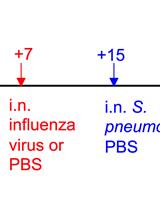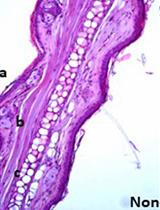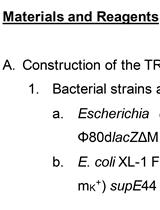- EN - English
- CN - 中文
Multicolor Stimulated Emission Depletion (STED) Microscopy to Generate High-resolution Images of Respiratory Syncytial Virus Particles and Infected Cells
利用多色受激发射损耗(STED)显微镜获取呼吸道合胞体病毒颗粒和感染细胞的高分辨率图像
(*contributed equally to this work) 发布: 2017年09月05日第7卷第17期 DOI: 10.21769/BioProtoc.2543 浏览次数: 9910
评审: Angela CoronaKristin ShinglerAnonymous reviewer(s)
Abstract
Human respiratory syncytial virus (RSV) infection in human lung epithelial A549 cells induces filopodia, cellular protrusions consisting of F-actin, that extend to neighboring uninfected cells (Mehedi et al., 2016). High-resolution imaging via stimulated emission depletion (STED) microscopy revealed filamentous RSV particles along these filopodia, suggesting that filopodia facilitate RSV cell-to-cell spread (Mehedi et al., 2016). In this protocol, we describe how to fix, permeabilize, immunostain, and mount RSV-infected A549 cells for STED imaging. We show that STED increases resolution compared to confocal microscopy, which can be further improved by image processing using deconvolution software.
Keywords: RSV (RSV)Background
RSV forms pleomorphic virus particles, with a predominance of long filaments about 100 nm in diameter and up to about 10 µm in length (Bachi and Howe, 1973; Mehedi et al., 2016). High-resolution light microscopy techniques are key to visualizing the interactions between RSV infected cells and virus particles. In a recent study, we used super-resolution fluorescence microscopy to study RSV cell-to-cell spread in human lung epithelial A549 cells.
STED microscopy is one of the super-resolution microscopy techniques that have been developed to circumvent the limitations imposed by the ~200 nm diffraction barrier of light (Hell and Wichmann, 1994; Westphal et al., 2008). STED is based on confocal fluorescence microscopy and employs a pair of lasers, namely a pulsed excitation source and a photon depletion source. The excitation pulse is focused on the sample and excites the fluorescent dye therein. The excitation laser is superimposed with a doughnut-shaped STED depletion laser that quenches excited dye molecules except for the doughnut hole at the very center of the excitation focus, so that emission occurs only from the narrow center. Narrowing the excitation focal point in this way allows for images to be taken at resolutions far below the diffraction limit, e.g., typically 30-80 nm. While STED imaging relies on efficient dye depletion, image resolution and intensity are limited by photobleaching inflicted upon the dye. To address these two contrasting, yet key issues that arise with STED imaging, optimal sample preparation, most notably dye selection and signal intensity optimization, are crucial. STED enabled us to state conclusively that RSV was attached to filopodia rather than merely in the vicinity, and to precisely enumerate viral particles. Here, we describe how samples were prepared for multicolor STED imaging including dye selection, fixation procedure, imaging parameters, and deconvolution. We show how STED and STED deconvolution can improve lateral resolution both qualitatively and quantitatively.
Materials and Reagents
- Aerosol resistant pipette tips
20 µl (Thermo Fisher Scientific, catalog number: 21-402-551 )
200 µl pipette tips (Thermo Fisher Scientific, catalog number: 02-682-255 )
1,000 µl pipette tips pipette tips (Thermo Fisher Scientific, catalog number: 21-402-582 ) - T225 cm2 flask with canted neck (Corning, Costar®, catalog number: 3001 )
- Microscope slides (super clean) (Scientific Device Laboratory, catalog number: 022 )
- Sterile 12 mm circle untreated cover glasses; thickness 0.13-0.17 mm (Carolina Biological Supply, catalog number: 633029 )
- 50 ml conical tube
- 24-well cell culture plate (Corning, Costar®, catalog number: 3524 )
- The cell line of interest (human respiratory epithelial A549 cells [ATCC, catalog number: CCL-185 ])
- Recombinant wild type RSV (A2 strain, GenBank KT992094) (virus stock with known virus titer, see Notes)
- TryLE Select cell dissociation reagent, stored at room temperature (Thermo Fisher Scientific, GibcoTM, catalog number: 12563 )
- Bovine serum albumin (BSA) standard (Thermo Fisher Scientific, Thermo ScientificTM, catalog number: 23210 )
- Anti-RSV F protein mouse monoclonal antibody (mAb) (Abcam, catalog number: ab43812 )
- Anti-beta-tubulin (9F3) rabbit mAb (Cell Signaling Technology, catalog number: 2128 )
- Goat anti-mouse Alexa Fluor 488 (AF488) (Thermo Fisher Scientific, catalog number: A11029 )
- Goat anti-rabbit IgG-Atto 647N (Sigma-Aldrich, catalog number: 40839 )
- Rhodamine phalloidin (CYTOSKELETON, catalog number: PHDR1 )
- ProLong Gold Antifade Mountant (Thermo Fisher Scientific, InvitrogenTM, catalog number: P36930 )
- Ultrapure methanol free formaldehyde prepared from paraformaldehyde (PFA) 16% solution, EM Grade (Polysciences, catalog number: 18814 )
- F-12 medium without additives, which is sold commercially as Ham’s F-12 nutrient mix (Thermo Fisher Scientific, GibcoTM, catalog number: 11765054 )
- Fetal bovine serum (FBS) (GE Healthcare, HyCloneTM, catalog number: SH30071.03 )
- L-Glutamine 200 mM (Thermo Fisher Scientific, GibcoTM, catalog number: 25030081 )
- Dulbecco’s phosphate buffer saline (DPBS) (Thermo Fisher Scientific, catalog number: 14190 )
- Triton X-100 (BioUltra, ~10% in H2O, Sigma-Aldrich, catalog number: 93443 )
- Trypan blue 0.4% solution (Lonza, catalog number: 17-942E )
- F-12 complete medium (see Recipes)
- 4% PFA (see Recipes)
- 0.05% Triton X-100 (see Recipes)
- 3% BSA (see Recipes)
Equipment
- Pipettes (Mettler-Toledo, RAININ, model: Pipet-Lite XLS )
- Humidified CO2 incubator (Thermo Fisher Scientific, Thermo ScientificTM, model: FormaTM Steri-CultTM )
- Centrifuge (Beckman Coulter, model: Allegra 25R )
- Leica TCS SP8 STED 3X system (Leica Microsystems, model: Leica TCS SP8 STED 3X ) equipped with:
- A white light excitation laser
- 592 nm, 600 nm, 775 nm depletion lasers
- HC PL APO 100x/1.40 oil STED white objective
- Gated HyD hybrid detectors
- A white light excitation laser
- Hemocytometer (Marienfeld-Superior, catalog number: 0680030 )
- Dumont NOC tweezer (Electron Microscopy Sciences, catalog number: 0103-NOC-PO-1 )
Software
- Images were acquired using LAS X software (version 3.1.1.15751) (Leica Microsystems)
- Images were deconvolved using Huygens deconvolution software (Huygens Essentials version 16.10.1.p3, Scientific Volume Imaging BV, Hilversum, The Netherlands)
- PRISM software version 7
Procedure
文章信息
版权信息
© 2017 The Authors; exclusive licensee Bio-protocol LLC.
如何引用
Mehedi, M., Smelkinson, M., Kabat, J., Ganesan, S., Collins, P. L. and Buchholz, U. J. (2017). Multicolor Stimulated Emission Depletion (STED) Microscopy to Generate High-resolution Images of Respiratory Syncytial Virus Particles and Infected Cells. Bio-protocol 7(17): e2543. DOI: 10.21769/BioProtoc.2543.
分类
微生物学 > 微生物-宿主相互作用 > 病毒
微生物学 > 微生物-宿主相互作用 > 体内实验模型 > 哺乳动物
细胞生物学 > 细胞成像 > 荧光
您对这篇实验方法有问题吗?
在此处发布您的问题,我们将邀请本文作者来回答。同时,我们会将您的问题发布到Bio-protocol Exchange,以便寻求社区成员的帮助。
提问指南
+ 问题描述
写下详细的问题描述,包括所有有助于他人回答您问题的信息(例如实验过程、条件和相关图像等)。
Share
Bluesky
X
Copy link













